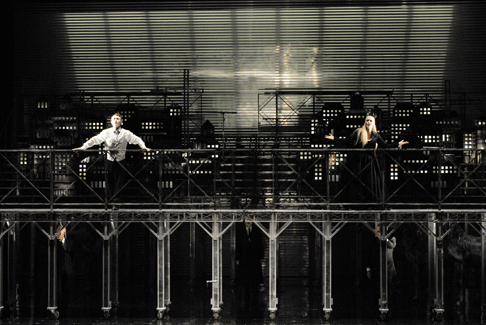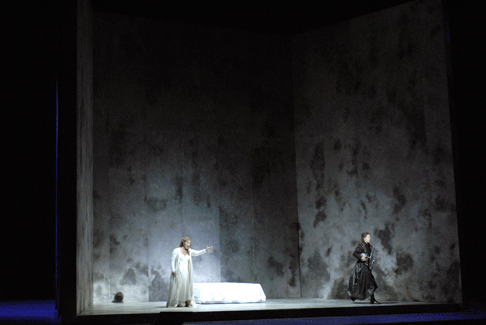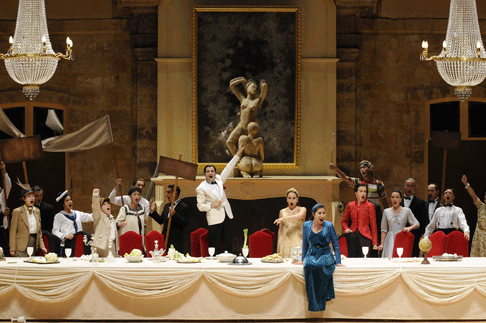19 Jul 2009
Festival Aix-en-Provence by Stéphan Lissner
The Aix Festival imagines itself one of Europe’s great festivals, defining itself as the crossroads of European culture.

The Aix Festival imagines itself one of Europe’s great festivals, defining itself as the crossroads of European culture.
This summer (July 3 - 31, 2009) is its sixty-first edition, though perhaps more importantly it is the twelfth edition of the Festival as re-invented by Stéphan Lissner. The Festival is now overseen by Bernard Foccroulle as Mr. Lissner has assumed the higher calling of setting things straight at Milan’s La Scala.
Miracles wrought by Mr. Lissner in his nine years at the helm in Aix (1998 - 2006) include revamping the Festival’s signature performing space, the open air 1300 seat Théâtre d’Archeveché, the construction of the Grand Théåtre de Provence, a 1400 seat indoor multi-purpose theater capable of hosting fairly large scale opera productions, the revitalization of a small, old Italian style theater, the Jeu de Paume for Festival use, inaugurating use of the Grand Saint Jean countryside park a few kilometers from Aix for small, technically simple productions, and establishing a facility for scenic construction. Whew.
Mr. Lissner conceived the Académie Européenne de Musique that has grown to include workshops in opera, lieder, chamber music, and opera production during the festival period (this summer there are eighty-five participants and a faculty of thirty). And he has conceived such magnificent opera projects as a Stéphane Braunschweig production of Wagner’s Ring with the Berlin Philharmonic and Sir Simon Rattle in the pit. This summer was its final installment, four performances of Götterdämmerung. Wow.
An enormous accomplishment indeed, though all that was lacking was good opera. Mr. Lissner’s artistic Ideas were pretentious, productions were ill-conceived, and performances were mediocre. It is hard to think of exceptions though surely there must have been some. Meanwhile the predominately French audiences did not seem to mind, as they flocked to performances. Go figure.
This summer, the third festival guided by Bernard Foccroulle, offers glimmers of hope that the tide has turned, this hope based on two productions seen in its opening days, Mozart’s Idomeneo and Offenbach’s Orphée aux Enfers. The Idomeneo was just what a festival production should be — one well beyond the scope of an ordinary season of opera. The orchestra was Les Musiciens du Louvre - Grenoble, playing on period instruments, the conductor Marc Minkowski is a specialist in period style. The production, by Olivier Py, pushed the envelope with huge, stilt-legged, light metal platform constructions that were in continuous, balletic motion, no electronically controlled horsepower here, only the flexed muscles and sweat of ten (or so) formally dressed, athletic grips (stagehands), these classy oversized nibelungens always in full, working view.
 A scene from Idomeneo
A scene from Idomeneo
Three and one half hours into the performance (performances begin a dusk, 9:30 PM, thus at 1 AM) we hit the ballet. Not only did the set elements begin to fly, i.e. move wildly around the stage, seven dancers retold the entire story in frenetic, fast forward pantomime for a final fifteen minutes. Then the house came down, including some French inflected boos (hoos in French). And the final curtain descended to a huge whoop from backstage — relief and pleasure that they had achieved a miracle, a flawless (or so it seemed) convergence of a myriad of elements realized against all possible odds.
The cast were fine young singers who continuously inter-played in complex staging with the monumental buildings of Crete, Idomeneo its shirt-sleaves-rolled-up master builder. Eminently striking was the use of a tenor voice for Idamante, Mozart’s original counter-tenor — the French back then and now too apparently never cottoning up to male mutilation even for artistic purposes. Absence of cross dressing (the mezzo as male) also makes story telling more direct these days though changing the clef (tessitura) of this voice robbed its music of much of its power.
Olivier Py’s concept was naive, if blatant — white and black, i.e. modern dressed Europeans and versus Africans in modern countryside regalia. Illa was a beautiful young singer of vaguely African origins, her dancer counterpart for the ballet was a lithely beautiful Black nymph, plus three strong, young black dancer warriors and two Brown Cretans. Not to mention a few real African figurants (supers). Of course the dynamic between Europeans and Africans is far from that of the Cretans and the Thebians so this heavy-handed social commentary look was far from appropriate. But who cares, the performance was magnificent.
 A scene from Götterdämmerung
A scene from Götterdämmerung
When it was all over suspicions arose that we had not heard the piece, short of a couple of show-stopping arias in the first act, the famous third act quartet having been lost amongst the choreography of the singers moving within the moving set. But this suspicion was quickly supplanted by the notion that this had been a true gesamtkunstwerk, a synthesis of all the arts that make opera — the rigid and controlled tempos appropriate to Baroque musical structures were realized on the primitive versions of modern instruments melting into the stark architectural structures moving dance like on the stage together with the supple bodies and pure young voices of idealized Mozartian singers. This production was proof that this Mozart opera transcends its music.
Operas in Aix are largely about conducting and staging. Less about singing. The price of a single ticket indicates what to expect. Ring tickets cost 350 euros each ($525), the singers biographies ticking off Bayreuth, Vienna, the Metropolitan Opera, Covent Garden, etc. Idomeneo tickets cost 210 euros ($315), its singers mixing often substantial major theater credits with important regional opera house credits, and finally the 170 euros ($255) price of an Orphée aux Enfers ticket provides entry level professionals and the occasional alumnus of the Aix Festival’s Académie programs.
The lower ticket price does not mean lesser attention to conducting and production, the Orphée aux Enfers as case in point. The show was in the pit, conductor Alain Altinoglu whipped up the Camerata Salzburg orchestra, here forty some players (more or less the number Offenbach used at the Theatre des Bouffes Parisienne in 1858 into a frenzy of amusing musical details that graciously titillated the far-from-subtle satire of Second Empire life. This lively young conducting star moved the musical action along at a comfortable, always lively toe-tapping pace until the can-can, taken at its fitting breakneck speed and danced (sort of) by everyone on stage (real dancers need slower tempi because they kick much higher).
 A scene from Orphée aux Enfers
A scene from Orphée aux Enfers
The fun was in the pit, far more than on the stage, the young singers, some less able than others to substantiate the larger-than-life personalities of Offenbach’s Olympian personalities. This however was the strength of Yves Beaunesne’s production. The young artists did what they could do without the usual overload of opera-stars-having-fun. Truly exceptional was the virtuoso violin mimicking of Orphée (Julien Behr) and the opera comedy monologue inserted by John Styx (Jérôme Billy) that had the audience and the orchestra (especially Mo. Altinoglu) in stitches.
The modest, and truly intelligent tone of the production was perfection, as it let the personalities of these charming young artists shine. There was no attempt to magnify the humor, to push to show over-the-top. Decors were cleverly created to capture the modesty of production of this first Offenbach operetta (this first version succeeding far more than its later Offenbach re-make, and countless productions since, all seeking to make the operetta fun when it already is — just ask Mo. Altinoglu). l The Olympus scenes were especially effective, a grand dinner party using the architectural elements of the facade of the old Episcopal palace, (now the back wall of the theater) bathed in a sickly yellow-gold light that was un-enviably other-worldly, with the drugged-out Olympians in gorgeous formal dress strewn about the stage (the costumer, Patrice Cauchetier wore a cream colored shirt printed with luscious giant red roses for the opening night bows).
The Götterdämmerung was, one assumes, a legacy of the Lissner regime. Stéphane Braunschweig is a director/designer, thus in principal achieves one unified vision without the distraction of collaboration. Mr. Braunschweig bestowed an exquisitely beautiful, ultra minimalist look (elevators rose and descended creating basic stair, bench, pit forms) evoked distilled abstractions of locale, the forest was an abstract sculpture of five, tall narrow trees. Mr. Braunschweig did not burden his “look” with a conception, his minimally costumed (basic black or white generic male or female shapes, save Siegfried who was in brown plaid) actors played Wagner’s domestic comedy in clean, very precise movements and placement, often with toes touching the edge of the downstage, i.e. facing directly into the hall. This very effective trick did not always work well. Brünnhilde stood there way too long while what we wanted was to see some real fire consume her.
This minimalist staging, believe it or not, held its own much of the time just above the splendor of the Berlin Philharmonic seated just below, Sir Simon Rattle pulling forth the Wagnerian leitmotifs with a purity of tone that seemed the primal discovery of mythic drama. This created a dramatic reality for the actors that heightened their sordid humanity, the soap opera baseness overcome by the solemnity of the music of Wagnerian philosophy. While true poetry sometimes emerged from the pit — the brass choir sang the break of day with splendid purity — little poetry was projected from the stage, the out-of-place realistic video of spring water undermined the usual poetic innocence of the charming encounter of the Rhine Maidens with Siegfried at the beginning of the third act.
When finally the medium sized square of video flames subsided, we saw the chorus dressed in shining white formal wear gazing down into a huge geometric pit that had opened through the floor of the stage. One longed for a Calixto Bieito resolution where the chorus would surely be naked (obligatoire), and where there would be an outhouse nearby (obligatoire) to make Wagner’s purified humanity even more primal, and to make our encounter with this nineteenth century artistic monument a real one.
It was, of course, Cadillac casting — fine singing actors who perform these roles on the world’s great stages, including Ben Heppner who was a fish out of water in this high “look” production.
Three operas in three days, a fourth to come later in the month. Imagine an Austrian orchestra, a French one no to mention the hundred and twenty of so players of the Berlin Philharmonic (not counting the five extra harps for Götterdämmerung), plus the Rundfunkchor Berlin, three full-scale, technically demanding productions and a host of opera singers plus the Académie participants, all this stuffed into this large town in the south of France, arguably the most charming town in France if not on earth. And there still seems plenty of room for capacity audiences at this true European cultural crossroad.
This month-long festival, operating on a budget of 20,000,000 euros ($30,000,000), is amazing indeed.
Michael Milenski